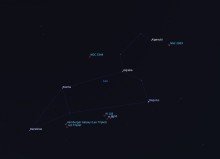Leo
Yet again, with the scarcity of observing opportunities lately, except for a brief but brilliant session with the local scouts group (I posted a brief report about this on my blog), my mind has turned to contemplating what there is to look forward to over the coming weeks and months. I mentioned in my last piece having spotted galaxy NGC 2903 off the front of the Leo constellation, and that got me thinking about the constellation itself and what its appearance in the night sky heralds for the coming months … basically, it’s galaxy season again!
Leo, rising in the east by about 10PM is one of the most recognizable constellations, and one that actually (kind of) looks like what it’s supposed to represent, and there’s lots to see within it’s borders. For DSO hunters like me Leo is a treasure trove.
Making up the front part of Leo, the stars are arranged into what appears to be a large sickle shape, or backwards question mark, the full stop at the bottom of which is Regulus. One of the brightest in the night sky, it’s actually made up of four stars in two pairs. The next brightest star in the curve of the sickle is Algieba, a binary star system, the colours of theorange-red and greenish-yellow components visible through a modest telescope.To the left of Regulus is the body of the lion, and this ends in a triangle of stars, the lower left-hand one is Denebola, a very young star, only 400 million or so years old.
As for the galaxies, and starting at the top, just off the front of the constellation is, as I’ve mentioned, NGC 2903, a relatively large, bright spiral galaxy, about 30 million light years away. Moderate telescopes (4-5 inch in diameter) should pick it up. I haven’t actually tried for it in binoculars, but it might be possible …
Above Leo (and actually within the borders of Leo Minor), lies the large, bright, face-on spiral galaxy NGC 3344. A larger aperture scope (say, 8+ inch Newtonian), should be able to pick up some detail in the spiral arms.
Below the left-hand side of the constellation, and to the right of Denebola, is the famous Leo Triplet (otherwise known as the M66 group), this time of year you’ll need to be out from 11PM onward to see it. Comprising M65, M66 and NGC 3628, this cluster of three galaxies, lying about 35 million light years away, is a remarkable sight, and even moderate binoculars should pick up two of the three, though you’ll need more magnification and aperture to see any detail. As I’ve mentioned in previous columns, I never tire of seeing several galaxies in the same field of view, and here we have three!
Another cluster of galaxies lies just below the middle of the constellation. The M96 group actually comprises up to 24 galaxies, though M95, 96 and 105 are the most readily observable ones. Although most definitely located within the Leo constellation, the M96 group is actually one of several galaxy clusters located within the Virgo Supercluster, and it’s when Virgo rises in the evening sky that we can say ‘galaxy season’ is well and truly under way. I’ll return to the galactic feast that is Virgo and Coma Berenices in a later piece, but for now I’ll just leave you with the taster that is Leo …
What’s up?
Xmas Day sees the return of the full moon, a treat for everyone who has received a new telescope or binoculars that day! To the south, around 10PM, you should see a very bright star in the constellation of Canis Major. This is Sirius, and is well worth a look. It’s actually the brightest star in the night sky, partly because it is inherently very bright, but also because, at only 8.6 light years away, it’s one of our Sun’s closest neighbours. By comparison, the light from the Sun takes on average 5.5 hours to reach Pluto … Sirius is a binary star system. Its tiny companion star, often referred to as ‘the Pup’, is a difficult challenge to spot (because it’s so close to its very bright companion), but is manageable. There are a number of nice star clusters in the Canis Major constellation. Messier 41 lies directly below Sirius, whilst off to the left of the star are M46 and M47. All are viewable with binoculars, and you should be able to resolve individual stars in the clusters with a moderate telescopes.
Happy Xmas, and clear skies!
Kevin Quinn is an amateur astronomer based in Cerne Abbas, he is the proud owner of a ten-inch reflector, a case of eyepieces, and a pair of 20×80 binoculars. He tweets via @CerneAstro, blogs via theastroguy.wordpress.com, and his ebook Demystifying Astronomy – A beginner’s guide to telescopes, eyepieces and accessories for visual astronomy is widely available.
©Kevin Quinn







